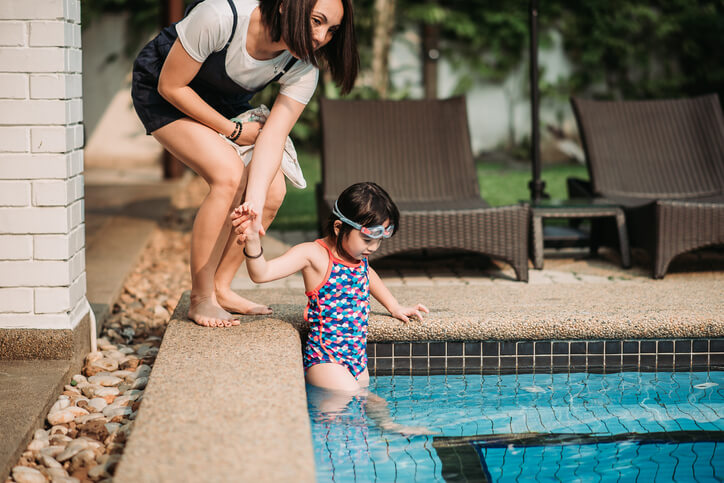POOL ENCLOSURES| POOL FENCING| PALISADE FENCING INSTALLERS & SUPPLIERS IN GAUTENG
Custom Steel Palisade pool fencing & stainless steel pool fencing
We design, supply and do installations the latest in residential & industrial Custom POOL ENCLOSURES in Gauteng.
There’s nothing quite like the refreshment of plunging into your pool on a sweltering summer day here in Gauteng. When it comes to creating your very own outdoor oasis that’s both safe and beautiful, pool fencing needs just as much consideration as the pool itself.
With so many styles and materials to choose from, it’s easy to find a fence that suits your taste, space and budget. Our team install pool fencing in Gauteng, and we’re here to help you choose the best pool fence for your property. We supply and install a range of styles.
As effective security fencing, palisade fencing with forbidding appearance, inherent strength and high damage resistance becomes the best choices of protection pool fencing. Designed with smooth surface, rigidity structure, sharp prongs and narrow pale spacing, the palisade fences are normally considered to be difficult even impossible to climb, straddle, grab and gain foothold. Thereby, it effective deters would to be intruders and trespassers, protects your assets, office and factory from damages.
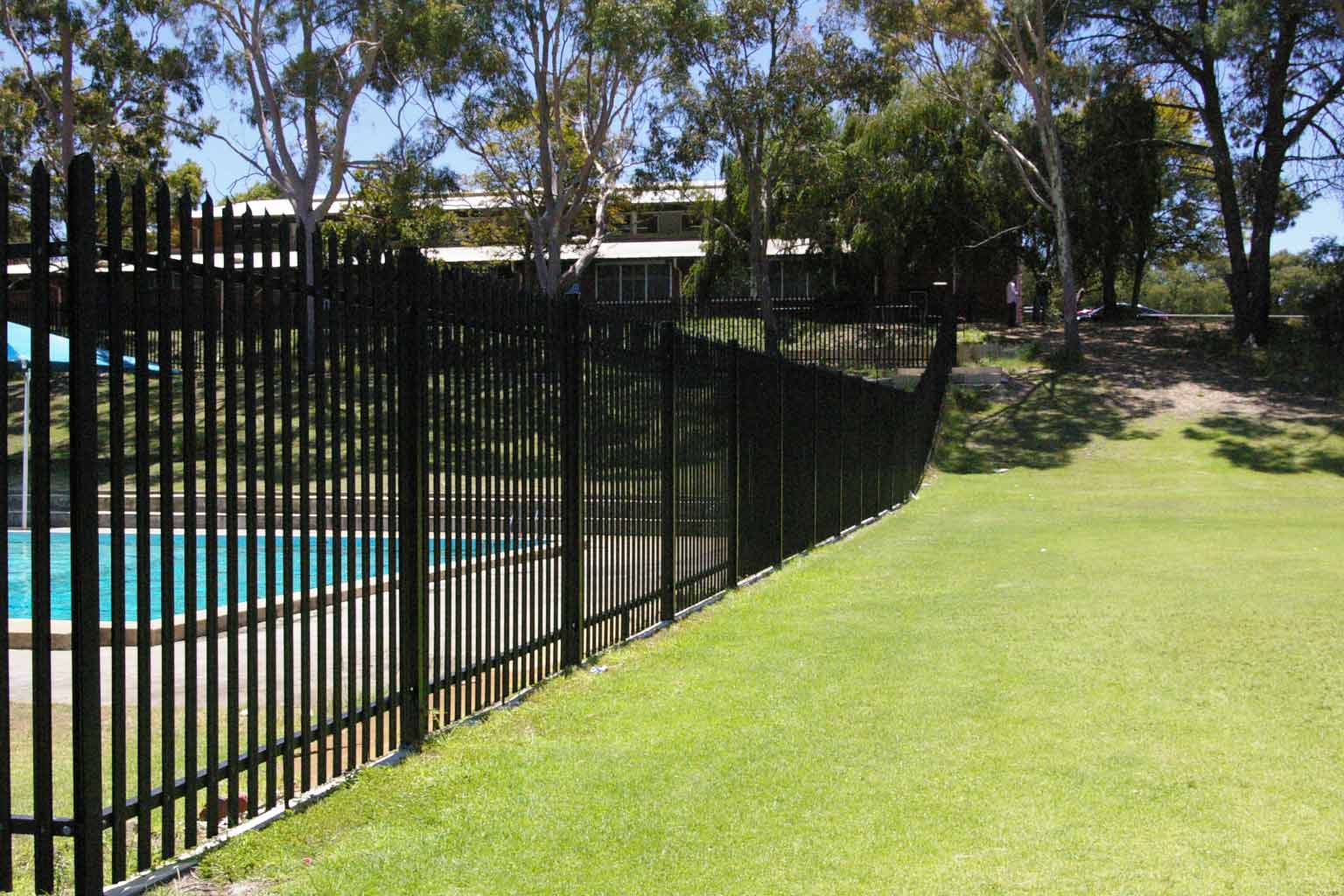
Pool Safety: Fences and Enclosures Secure Your Pool & Protect Kids
Summer is a time for fun in the sun, and what could be more fun than having a pool in your backyard? Pool fencing is an important part of keeping your pool safe. It can help prevent accidents and keep your loved ones safe. In this blog post, we will discuss the benefits of pool fencing and why you should consider installing one for your home.
SAFETY BENEFITS
Swimming pool fences can provide a number of benefits for your home. First, it can help keep your family safe. Pool fencing can help prevent accidents by creating a barrier between the pool and the rest of the yard. This barrier can help to keep children and pets from accidentally falling into the pool. Additional safety features can be added such as gate latches, which can help to keep the pool area secure.
Prevent Liability
This one's very important. Even if you don't have pets or children, your neighborhood probably does. If a child wanders into your yard and falls into your pool, it is your problem in most cases. Each state has different laws regarding pool enclosures and overall pool safety. Many states regulate the height of fences to be taller than your typical chain-link fence. Just about all states say that in order to not be liable for a trespasser's injuries, you need to have your pool fully fenced in and locked at all times. If you do not follow the state's pool fence regulations then you will be liable for any incidents that occur in or around your pool and you will have no legal ground for defense because you would be considered a "negligent" pool owner. Fences that are sturdy, tall, and lockable make pool areas much safer and can deter or prevent trespassers from entering.
Keep Pets Safe
If you don't have children you should still get a pool enclosure. Pets can fall into pools just as easily as a child. While many breeds of dogs can instinctively swim, some breeds are not built for it at all. Even if your pup can swim, they may not be able to get themselves back out of the pool. Remember that dogs can't use ladders. Pool ledges don't give very much traction for puppy paws, so they might get stuck treading water. Pool enclosures are especially important for households with breeds that don't swim, puppies, or disabled dogs. Pugs, Boxers, Bulldogs, Basset Hounds, Dachshunds are just a few of the breeds who anatomically can't swim well. Keep your pup safe and install a fence around your pool.
PRIVACY BENEFITS
Second, pool fencing can provide privacy for your family. If you have young children, you may not want them to be able to see into the pool area. Or, you may not want neighbors or onlookers peering into your yard as your family plays in the pool or you’re out sunbathing on the deck. Pool fencing can help to create a more private space for your family to enjoy.
PEACE OF MIND
Pool fencing can provide peace-of-mind for your family. If you have a pool, you may worry about the safety of your loved ones, especially if you have young children. Pool fencing can help to ease these worries by creating a safe and secure space for your family to enjoy.
AESTHETICS
Pool fencing can improve the aesthetics of your home. A well-designed and installed pool fence can enhance the look of your home and yard. Pool fencing is available in a variety of materials, colors, and styles to suit your needs.
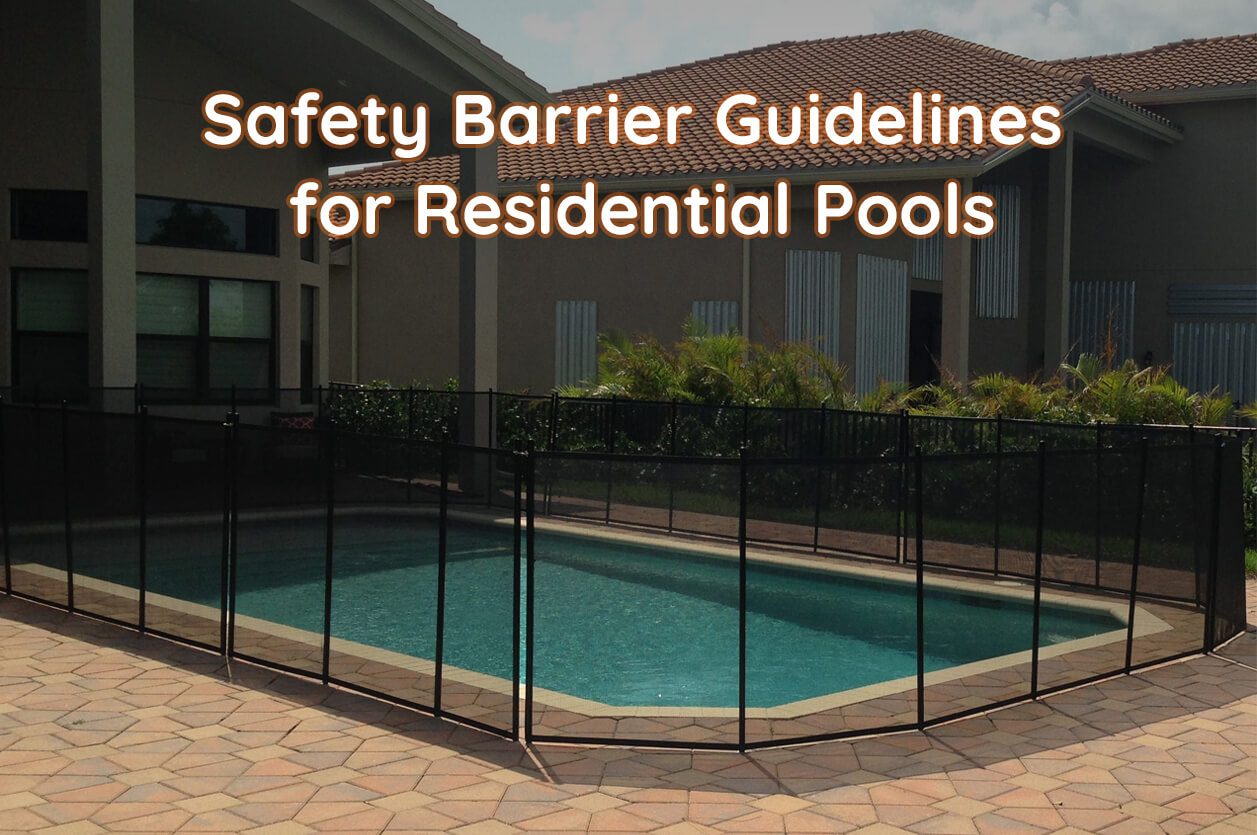
Safety Barrier Guidelines for Residential Pools
Preventing Child Drownings
Many communities have enacted safety regulations for pool enclosures at residential swimming pools—in ground and above ground. In addition to
following laws, parents who own pools can take their own precautions to reduce the chances of their youngsters accessing the family or
neighbors’ pools or spas without supervision.
Each year, thousands of American families suffer swimming pool tragedies—drownings and near-drownings of young children. The majority
of deaths and injuries in pools and spas involve young children ages 1
to 3 and occur in residential settings. These tragedies are preventable.
Pool enclosures/ pool fencing are not the sole method to
prevent pool drowning of young children and cannot replace adult
supervision.
Many of the nearly 300 children under 5 who drown each year in
backyard pools could be saved if homeowners completely fenced in
pools and installed self-closing and self-latching devices on gates.
Anyone who has cared for a toddler knows how fast young children can
move. Toddlers are inquisitive and impulsive and lack a realistic sense of
danger. These behaviors make swimming pools particularly hazardous
for households with young children.
Fences
A fence completely surrounding the pool is better than one with the
house serving as the fourth side. Fences should be a minimum of 4 feet
high, although fences 5 feet or higher are preferable.
If the home serves as one side of the barrier install door alarms on all
doors leading to the pool area. Make sure the doors have self-closing
and self-latching devices or locks beyond the reach of children to
prevent them from opening the door and gaining access to the pool.
Pool covers add another layer of protection and there are a wide
variety of styles on the market. Keep pool covers well-maintained and
make sure the control devices are kept out of the reach of children.
A successful pool enclosure prevents a child from
getting OVER, UNDER, or THROUGH and
keeps the child from gaining access to the pool
except when supervising adults are present.
How To Prevent a Child from Getting OVER a Pool enclosure/ fencing
A young child can get over a pool enclosure/ fence if the barrier is too low or if the barrier has handholds or footholds to use when climbing. The top of a pool barrier should be at least 48 inches above grade, measured on the side of the barrier which faces away from the swimming pool. Some states, counties or municipalities require pool enclosures of 60 inches.
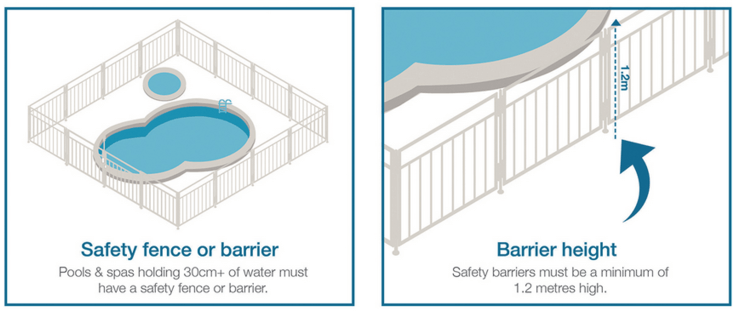
For a Solid fence
No indentations or protrusions should be present, other than normal construction tolerances and masonry joints.
For a fence Made Up of Horizontal and Vertical Members
If the distance between the top side of the horizontal members is less than 45 inches, the horizontal members should be on the swimming pool side of the fence.
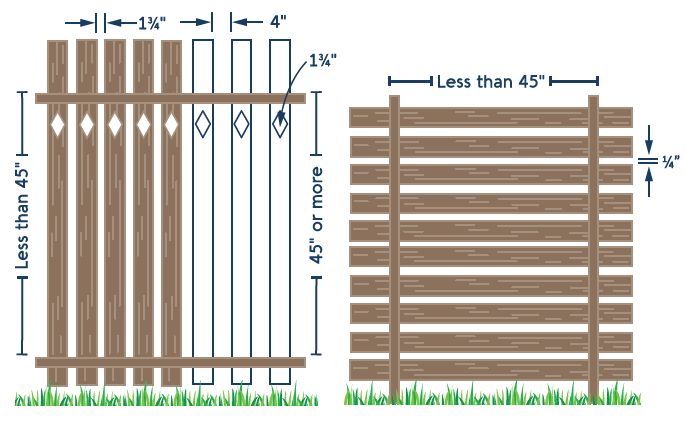
The spacing between vertical members and within decorative cutouts should not exceed 1¾ inches. This size is based on the foot width of a young child and is intended to reduce the potential for a child to gain a foothold and attempt to climb the fence.
If the distance between the tops of the horizontal members is more than 45 inches, the horizontal members can be on the side of the fence facing away from the pool. The spacing between vertical members should not exceed 4 inches. This size is based on the head breadth and chest depth of a young child and is intended to prevent a child from passing through an opening. If there are any decorative cutouts in the fence, the space within the cutouts should not exceed 1¾ inches.
For a Chain Link Fence
The mesh size should not exceed 1¼ inches square unless slats, fastened at the top or bottom of the fence, are used to reduce mesh openings to no more than 1¾ inches.
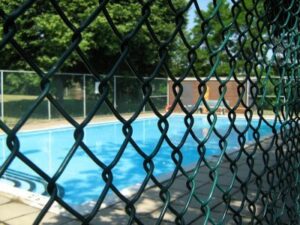
For a Fence Made Up of Diagonal Members or Latticework
The maximum opening in the lattice should not exceed 1¾ inches.
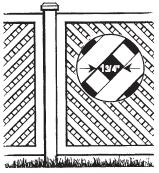
For Above Ground Pools fencing
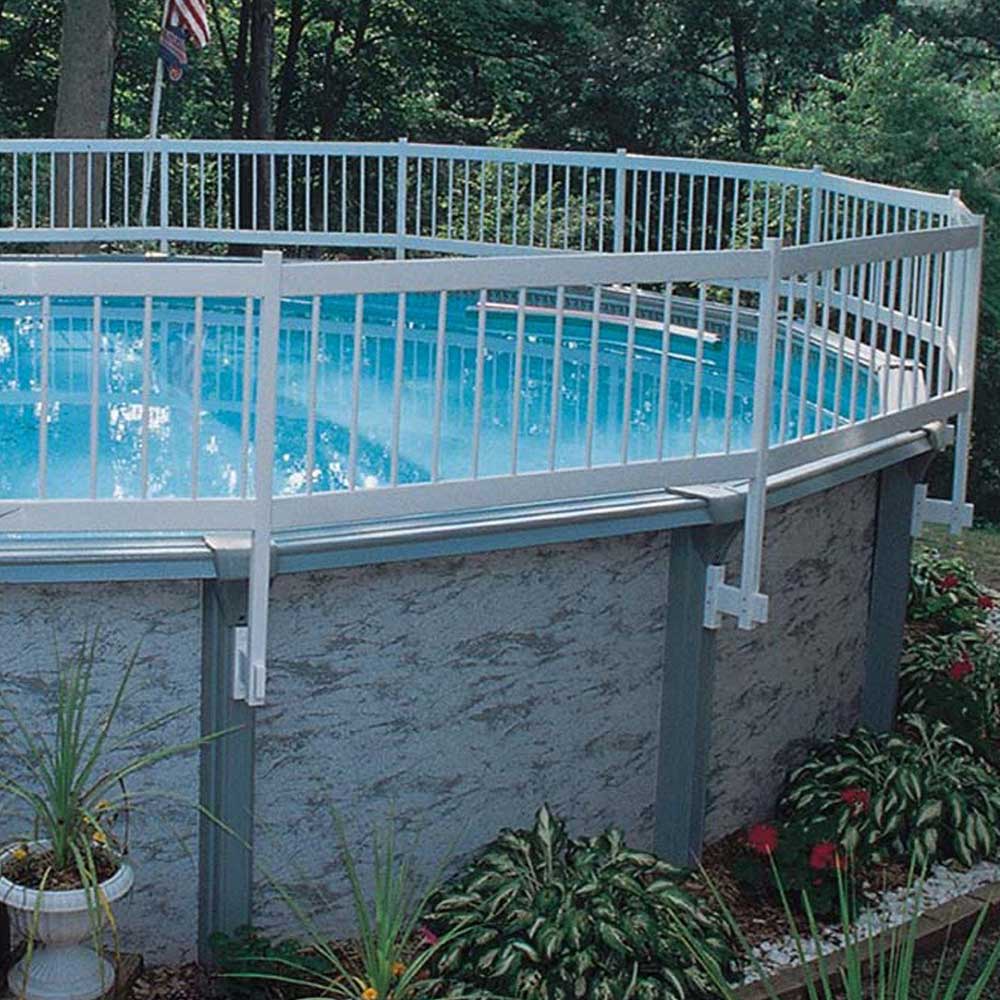
Above ground pools should have fences. The pool structure itself serves as a fence or a fence is mounted on top of the pool structure. There are two possible ways to prevent young children from climbing up into an above ground pool. The steps or ladder can be designed to be secured, locked or removed to prevent access, or the steps or ladder can be surrounded by a fence such as those described in these guidelines.
Above Ground Pool with Barrier on Top of Pool
If an above ground pool has a barrier on the top of the pool, the maximum vertical clearance between the top of the pool and the bottom of the barrier should not exceed 4 inches.
How to Prevent a Child from Getting UNDER a Pool enclosure
For any pool enclosure, the maximum clearance at the bottom of the fence should not exceed 4 inches above the surface or ground when the measurement is done on the side of the barrier facing away from the pool. Industry recommends that if the bottom of the gate or fence rests on a non-solid surface like grass or gravel, that measurement should not exceed 2 inches.
How to Prevent a Child from Getting UNDER a Pool fence
Preventing a child from getting through a pool enclosure can be done by restricting the sizes of openings in a fence and by using self-closing and self-latching gates. To prevent a young child from getting through a fence or other barrier, all openings should be small enough so that a 4-inch diameter sphere cannot pass through. This size is based on the head breadth and chest depth of a young child.
Portable Pools
Portable pools are becoming more
popular. They vary in size and
height, from tiny blow-up pools to
larger thousands-of-gallons designs.
Portable pools present a real danger
to young children.
Never leave children unsupervised
around portable pools. It is recommended that portable pools be
fenced, covered or emptied and
stored away. Instruct neighbors,
friends and caregivers about their
presence and the potential dangers
of a portable pool in your yard.
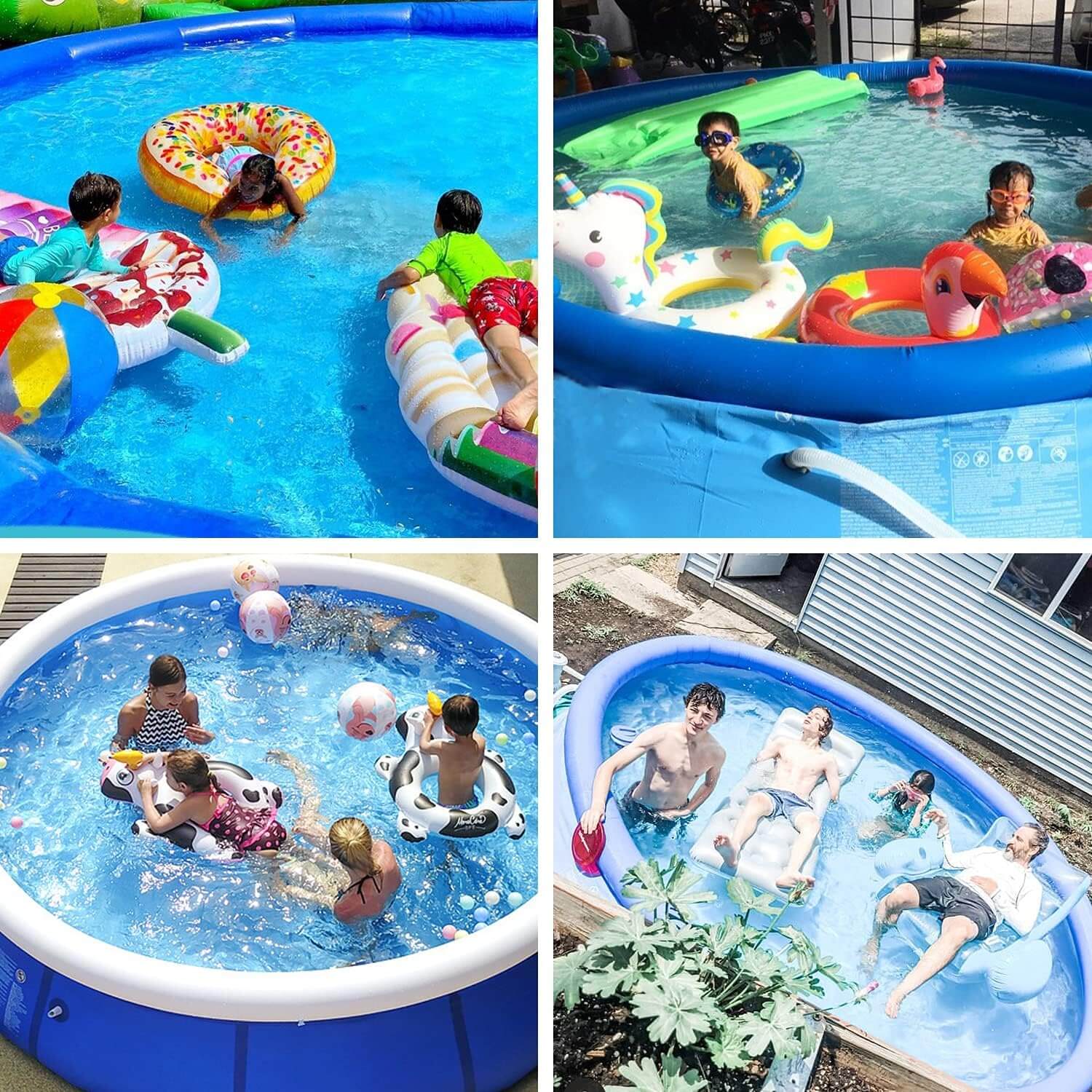
Removable Mesh Fences
Mesh fences are specifically
made for swimming pools or
other small bodies of water.
Although mesh fences are meant
to be removable, the safest mesh
pool fences are locked into the
deck so that they cannot be
removed without the extensive
use of tools.
Like other pool fences, mesh fences should be a minimum of 48” in
height. The distance between vertical support poles and the attached
mesh, along with other manufactured factors, should be designed
to hinder a child’s ability to climb the fence. The removable vertical
support posts should extend a minimum of 3 inches below grade and
they should be spaced no greater than 40 inches apart. The bottom
of the mesh barrier should not be more than 1 inch above the deck or
installed surface.
Gates
There are two kinds of gates which might be found on a residential property: pedestrian gates and vehicle or other types of gates. Both can play a part in the design of a swimming pool enclosure. All gates should be designed with a locking device.
Pedestrian Gates
These are the gates people walk
through. Swimming pool enclosures
should be equipped with a gate or
gates which restrict access to the
pool.
Gates should open out from the
pool and should be self-closing
and self-latching. If a gate is properly designed and not completely
latched, a young child pushing
on the gate in order to enter the
pool area will at least close the
gate and may actually engage
the latch.
When the release mechanism of the
self-latching device on the gate is less
than 54 inches from the bottom of
the gate, the release mechanism for
the gate should be at least 3 inches
below the top of the gate on the side
facing the pool. Placing the release
mechanism at this height prevents a
young child from reaching over the top
of a gate and releasing the latch.
Also, the gate and barrier should have
no opening greater than 1/2 inch
within 18 inches of the latch release mechanism. This prevents a young
child from reaching through the gate and releasing the latch.
When the House Forms Part of the Pool Enclosures
In many homes, doors open directly from the house onto the pool area
or onto a patio leading to the pool. In such cases, the side of the house
leading to the pool is an important part
of the pool fence. Passage through any
door from the house to the pool should be
controlled by security measures.
The importance of controlling a young
child’s movement from the house to pool
is demonstrated by the statistics obtained
in CPSC’s submersion reports. Residential
locations dominate in incidents involving
children younger than 5 accounting for
85% of fatalities and 54 percent of injuries.
Door Alarms
All doors that allow access to a swimming pool should be equipped with an audible alarm which sounds when the door and/or screen are opened.
Self-closing doors with self-latching devices could be used in conjunction with door alarms to safeguard doors which give access to a swimming pool.
Pet or Doggy Doors
Never have a pet or doggy door if the door leads directly to a pool
or other backyard water. An isolation barrier or fence is the best
defense when pet doors are installed. Remember, pet door openings,
often overlooked by adults, provide curious children with an outlet
to backyard adventure. Locking these doors is not sufficient and
could lead to accidents and tragedies.
Children regularly drown in
backyard pools, which they were able to access through pet doors.
Some municipalities have building codes that prohibit doggy doors in
homes with pools unless there is an isolation fence around the pool.
Indoor Pools
When a pool is located completely within a house, the walls that surround the pool should be equipped to serve as pool safety fences. Measures recommended for using door alarms, pool alarms and covers where a house wall serves as part of a safety barrier also apply for all the walls surrounding an indoor pool.
Rule # 1: Never leave a child unattended around a pool, spa, bath tub, or any body of water.
At pools, spas, and other recreational waters:
